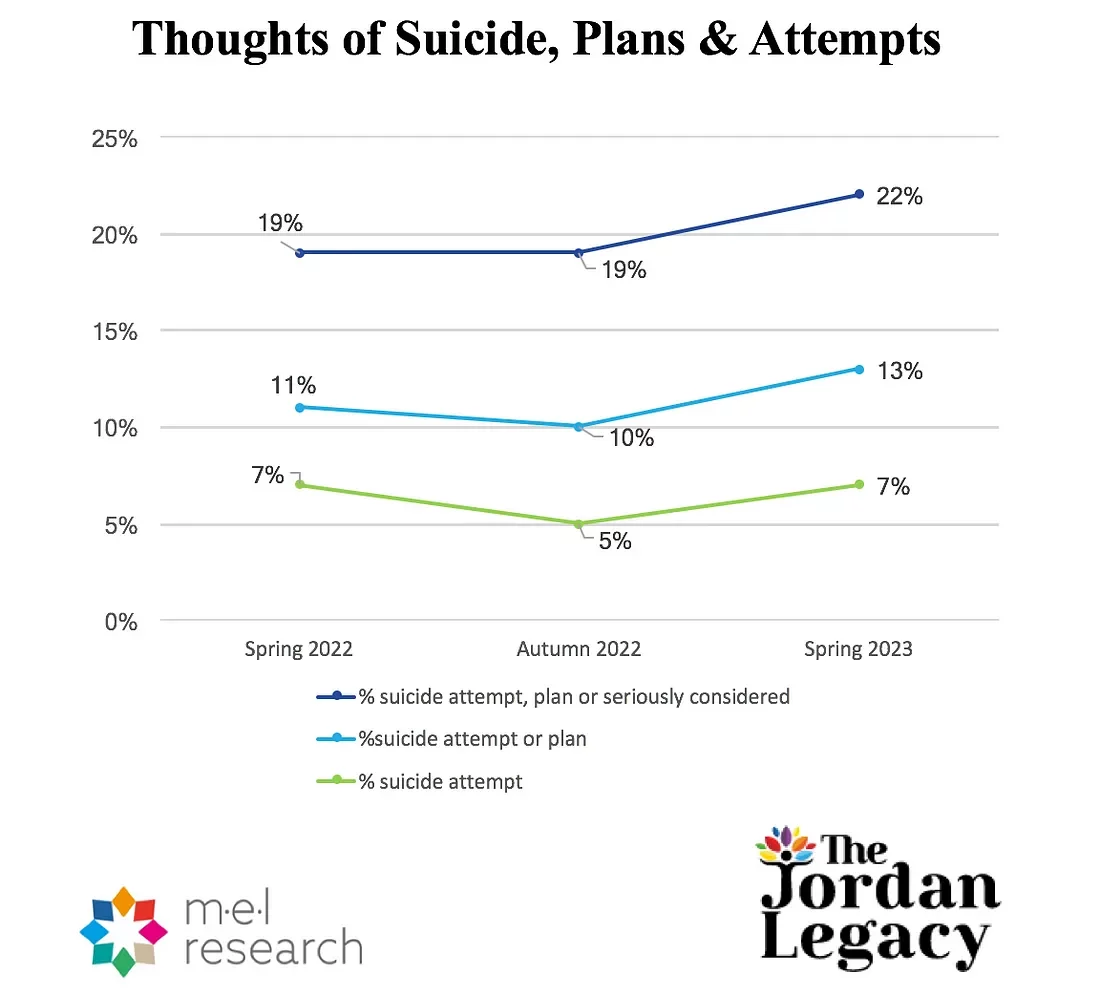Moving Towards a Zero Suicide Society — how far we have to go
This report includes some of the latest data from The Jordan Legacy/MEL Research ‘Omnibus’ Survey which questions a nationally representative sample of 1500 adults (aged 16+) in the UK and is generating key data for us on suicide, suicide prevention and mental health twice a year; along with the ‘Zero Suicide Society’ actions The Jordan Legacy has highlighted to get the UK suicide numbers on a downward trend ‘towards zero’.
This hybrid article/research report is authored by Paul Vittles, The Jordan Legacy’s former collaborative partner. Paul originally published this piece on Friday 8 September in time for World Suicide Prevention Day 2023 on the Medium platform. You can read it there via this link to the original article published on Medium or here on The Jordan Legacy website – below”
If you quote any of the results from this survey/article-report, please give your source as The Jordan Legacy/MEL Research Survey, and link to this published summary to ensure accuracy and to avoid misrepresentation.
Given the subject matter, all those taking part in the survey are directed to sources of support. If you or anyone you know needs support, there are many options (and it’s important to know there are many options!), including via the Help & Resources page on The Jordan Legacy website.
And, of course, this write-up is going to be covering the subject of suicide (along with the positive and hopeful subject of suicide prevention!) so if you find this triggering or distressing in any way, please seek support.
This report also summarises the context in which this survey and The Jordan Legacy’s action research project are being undertaken, all to help us reduce the suicide numbers and move us towards a ‘Zero Suicide Society’.
Future reports will focus on the core survey results, along with ‘deep dives’ into particular topics or perspectives covered by the survey, eg the next report will be a more in-depth feature on education & training sources and their impact.
But here, publishing around World Suicide Prevention Day 2023, this report has included a link to the report from the first survey MEL Research carried out as part of its partnership with The Jordan Legacy in Spring 2022 and summarised the amazing strides Steve Phillip and I have taken since (in Spring 2022, Steve and Paul were having an unpaid sabbatical helping to develop the concept, vision & strategy for the Baton of Hope, before switching their focus back to The Jordan Legacy’s important work in Autumn 2022, when the second wave of our national tracking survey took place).
Let’s Talk about Suicide!
The very first ‘baseline’ survey (which had some insightful questions about ‘facts & myths’ and societal attitudes towards suicide, suicide prevention, and mental health — worth looking at) was carried out in Spring 2022, and was reported as “Let’s Talk about Suicide”. The results of this survey can be viewed via this link.
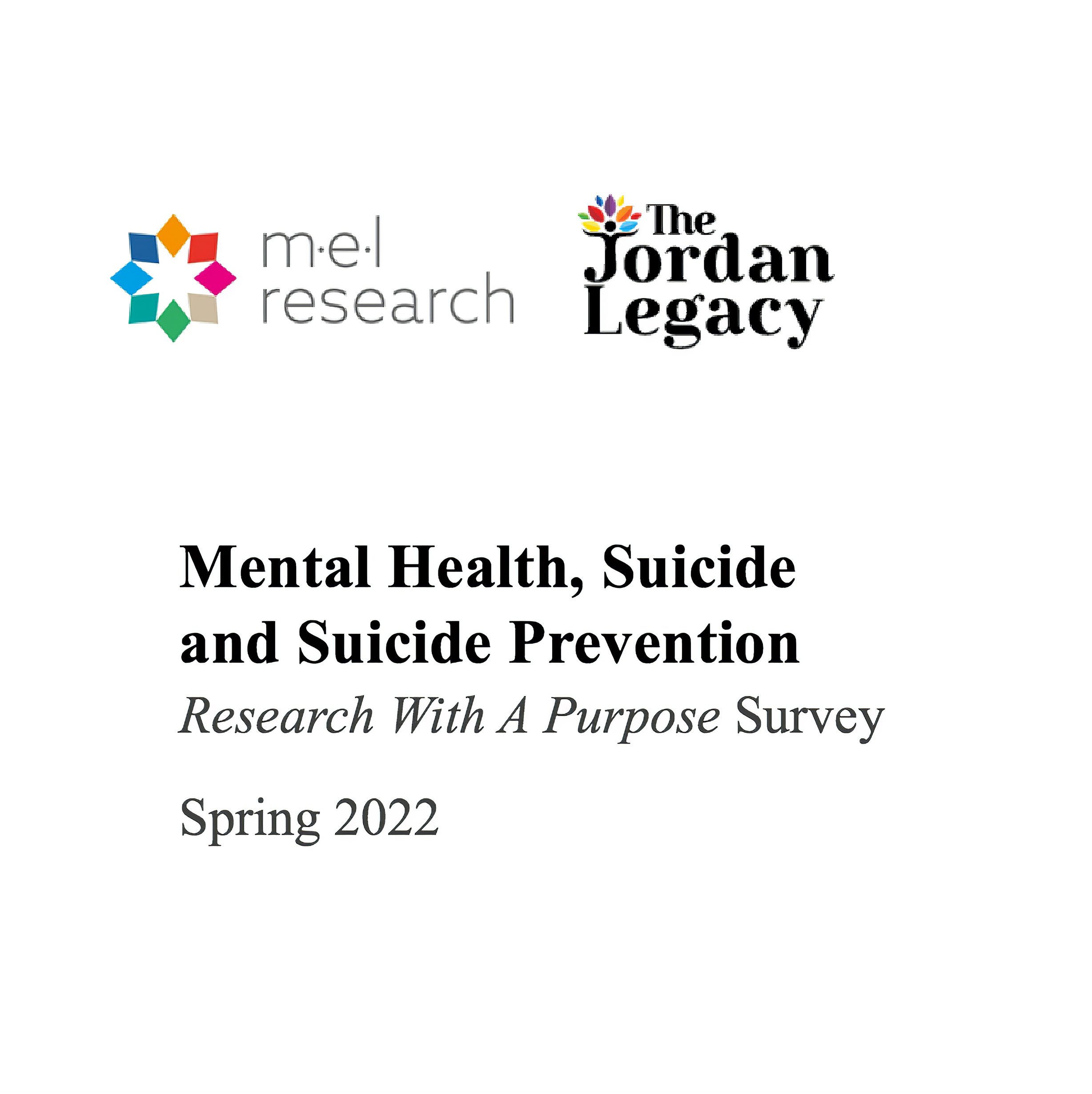
That first survey was also presented (by myself) at an online event — also entitled “Let’s Talk about Suicide” — hosted and facilitated by The Jordan Legacy, including a post-presentation panel discussion with experienced training professionals, Steve Carr and Tara Powell.
You can access the recording via this link.
Much has Happened, Much is Happening!
Since that first survey and first survey report, much has happened.
Not only have there been two further waves of The Jordan Legacy/MEL Research Survey (in Autumn 2022 and Spring 2023 — results coming up later in this report) but The Jordan Legacy has been busy with its conferences, events & workshops; facilitated peer support sessions for Mental Health First Aiders; its fortnightly radio show — Jordan’s Space — which provides a platform for diverse ‘lived experience voices’ (and a great educational resource for learning about diverse lived experiences).
…plus our advocacy & campaigning; and our action research project.
The ‘Moving Towards a Zero Suicide Society’ Action Research Report
Indeed, the first output from that action research project was a report, co-authored by Paul and Steve Phillip entitled “Moving Towards a Zero Suicide Society”, which was published on 11 July 2023. Read the full report below or via this link.
 Loading...
Loading...
The significance of that date is that it would have been Jordan’s 38th Birthday, had he not ended his own life in December 2019…and Jordan of course is the reason why The Jordan Legacy exists — to honour Jordan’s life; to try and stop other people having to endure the pain of loss to suicide experienced by those who loved Jordan; and to get the suicide numbers on a downward trend ‘towards zero’ as a key part of Jordan’s legacy.
The significance of that report is that it’s having a huge impact around the country with many of those reading the report regarding it as a breakthrough for suicide prevention in the UK, notably by mapping out a detailed practical vision of what a ‘Zero Suicide Society’ looks like — going way beyond the initial definition Steve and I set out in January 2023 as “a society that is willing and able to do all it can to prevent all preventable suicides” — and including the practical actions we can all take to make a difference; actions communities and workplaces can take; and actions we need government to take.
The Jordan Legacy has held webinars to go through the report content and the ‘Zero Suicide Society’ vision. Here’s a recording:
Btw, we have taken on board the huge quantity and fabulous quality of feedback on that initial report, and a 2nd Edition was published on 28 September, including an Executive Summary that, among other things, has a detailed exposition and explanation of the ‘Zero Suicide Society’ transformation model & framework:
https://thejordanlegacy.com/moving-towards-a-zero-suicide-society-edition-2-of-the-report/
Our Petition for a Suicide Prevention Act
Those actions identified in our action research project which we need government to take to be able to ‘move towards zero’, including the ‘systems change’ and transformational change required, have also been put into a package of proposals for a Suicide Prevention Act, and a petition launched (target: 100,000 signatures — the number needed for a Parliamentary evidence hearing and debate — by 19 January 2024).
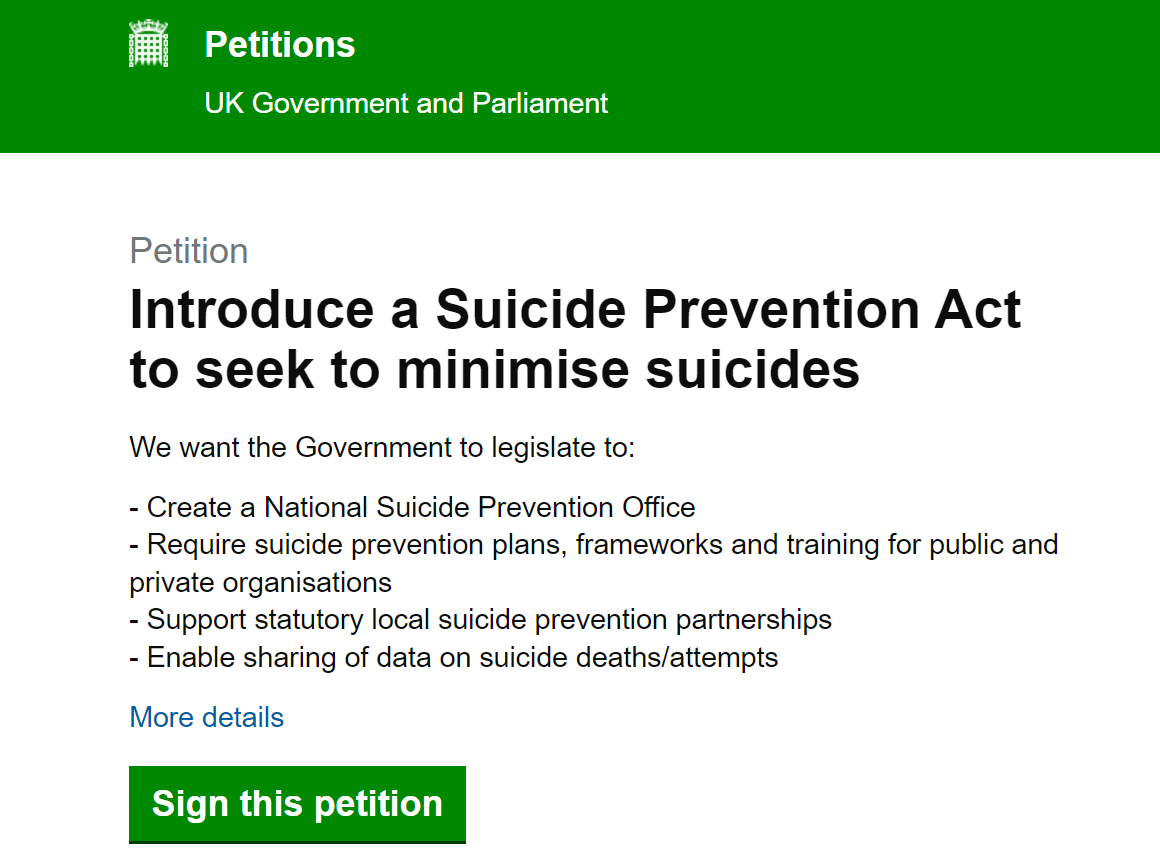
A Note on ‘Zero’, ‘Zero Suicide’, and ‘Zero Suicide Society’
Please note that a ‘Zero Suicide Society’ does not mean a utopian world where there are never any deaths by suicide. We know that despite the best efforts of loved ones, clinicians, and many people providing many different types of support, we still lose some people to suicide.
There are many sensitivities to take into account and different perspectives out there on what these terms mean, and that’s why The Jordan Legacy put out a clear statement on this in January 2023, including defining a ‘Zero Suicide Society’ as “a society that is willing and able to do all it can to prevent all preventable suicides”.
Most Suicides Are Preventable, So Let’s Prevent Most Suicides!
What the evidence tells us though is that most suicides are preventable, so our goal must surely be to prevent most suicides…and do all we can to reduce the number of preventable deaths to as close to zero as possible.
It’s not easy to achieve that though. Suicides are often complex and messy and usually multi-faceted with lots of different contributory factors — it often being difficult to single out any particular causal factor.
And, of course, when we talk about ‘getting the numbers down’, these ‘numbers’ are actually human beings who’ve experienced lives, illness, circumstances that have led to them leaving this world (and I deliberately say ‘leaving’ not ‘wanting to leave’ because many of these people wouldn’t have felt they had a choice)…and each individual ‘case’ is unique with their own mix of mess and pain and hopelessness and sense of entrapment.
We describe much of this complexity in our ‘Moving Towards a Zero Suicide Society’ report, and cover it in our webinars, including the issues around mental health or mental illness and all of the other factors — from socio-economic factors to chronic physical illness — as well as the complexity involved in ‘moving towards zero’ including having continuous, systemic action learning (CSAL), lived experience involvement every step of the way, and an integrated, co-ordinated approach where “everyone is a priority for someone”…
…not falling into ‘The Priority Trap’ which is often a feature of government, National Strategies and many suicide prevention initiatives where the focus on setting priorities and developing plans around priorities means it’s a competition — not the truly collaborative approach we need — and a competition which, by definition, has ‘winners and losers’ which we simply cannot have when we value all lives equally…and want to drive the suicide numbers down towards zero, from the totally unacceptable level of 6,000+ deaths by suicide each year in the UK where, sadly, it has been for the past 15 years.
In our ‘Moving Towards a Zero Suicide Society’ report (and in our webinars), we also discuss barriers to getting the numbers down, like ‘The Priority Trap’ highlighted above, and the psychology of change in a field like suicide prevention, including the fact there is little belief at national level that we can ‘move towards zero’ but at local level there is often total belief we can get those numbers down — so, hey, let’s get all those ‘micro zeros’ adding up to a ‘macro zero’!
The Role of Data and Evidence in Helping and Not Harming
Some of the barriers to getting the suicide numbers down are data-related — not having (up-to-date, accurate) key data; not having real-time data (though this is now changing due to the long overdue implementation of Real Time Suicide Surveillance Systems); priorities in national strategies being set based on limited data or ‘emerging evidence’ (eg from one local area not many, or via ‘effective single issue campaigns as data’); new ideas that are potential life-savers not being pursued due to ‘lack of evidence’; and a resistance from ‘the establishment’ to embrace new forms of data and evidence, including the potential for Augmented Intelligence Systems for detection and early intervention to save lives.
The Jordan Legacy/MEL Research Survey — Patterns & Trends
One of the main reasons why The Jordan Legacy partnered with MEL Research — apart from the fact that MEL Research has been incredibly supportive and generous in trying to help us in our mission to move towards a Zero Suicide Society! — …
…is that we could see gaps in the data: key figures we need but didn’t have; lack of up-to-date figures; government sources and some of the big charities regularly quoting figures in their public statements or on their websites from ‘official surveys’ carried out in 2014 or even 2007 when this is clearly way out-of-date (and it says a lot about the low priority given to suicide prevention when key measures are not continuously monitored); and a lack of basic ‘tracking’ of key measures.
So, The Jordan Legacy/MEL Research Survey was established — among a nationally representative sample of UK adults (aged 18+ for the baseline survey in Spring 2022, and aged 16+ for the two subsequent waves in Autumn 2022 and Spring 2023).
Core Tracking Questions Plus Opportunity to Add ‘Topical Issues’
There are a set of core questions asked on each wave of the survey so we can monitor trends as well as patterns in the data (subject to that very minor adjustment from Wave 1 to Wave 2, going from 18+ to 16+).
Then there is the opportunity to ask some different questions on each wave of the survey.
In the Wave 1 ‘Baseline’ Survey (see link through to “Let’s Talk about Suicide” at the very top of this piece), there were some questions covering ‘facts and myths’, including checking what % of the population believe some basic facts and common myths to be true or false (or ‘don’t know’ or ‘prefer not to say’), along with some questions around key (societal) attitudes on suicide and suicide prevention.
In Wave 2 (Autumn 2022), these ‘facts & myths’ questions and the attitudes to suicide/SP questions were replaced with a question about training received or information sources used and a question about confidence in talking about suicide — two questions we can cross-analyse of course to be able to see what effect education & training has on confidence in talking about suicide.
These new questions were repeated in the Wave 3 Survey (Spring 2023) and we will continue to track these key measures.
It means we can study the relationship between training/information and confidence in having conversations around suicide — and, not surprisingly, those who complete training are far more likely to feel confident in both starting and continuing conversations about suicide.
And it means we can track this over time, in terms of the proportion of the population being trained, and the longer-term impact of this, as well as hopefully seeing significant growth in the proportion of the population feeling confident talking about suicide.
Whilst we’re on the subject of ‘training to be competent and confident in talking about suicide’, if you haven’t completed the Zero Suicide Alliance (ZSA) Gateway training, please, please, please do so NOW!
It’s evidence-based, it’s lived experience informed, it’s NHS-endorsed, it’s been completed 2.5 million times (but still nowhere near enough!), it’s online, it takes just 20 minutes, and it’s free!!!
You can take this training now via this link.

Incidence of Thoughts of Suicide, Plans, and Attempts
If we as a country and as a society are serious about trying to reduce the numbers of suicide deaths, and suicide attempts (and to reduce the number of suicide deaths we must reduce the number of suicide attempts of course), then we must have regular monitoring of, and up-to-date data, on suicide deaths, plans and attempts.
Despite calls for many years for ‘Real Time Data’ on suspected suicides, it wasn’t until the COVID19 pandemic that we finally made serious progress on ‘Real Time Suicide Surveillance’ (RTSS) systems and reporting, with national and local teams and partnerships studying this data stream on suspected suicides (long before completed Inquests decide if it was a suicide ‘on the balance of probabilities’ — itself a lower ‘burden-of-proof’, moving away from ‘beyond reasonable doubt’, only introduced in 2018–19.
Prior to this, the data for suicide deaths tended to be reported or published at least 9 months out-of-date, eg ONS data for England & Wales being published in September for the previous calendar year, eg published in September 2019 for deaths registered in 2018.
Meanwhile, it can be very hard if not impossible to get hold of data on suicide attempts.
There are some ‘pockets of excellence’ where particular hospitals or health trusts or local suicide prevention partnerships have gathered good data and set up good monitoring systems for suicide attempts, including coming through A&E as a minimum and sometimes going much further.
But there are also many ‘black holes’ where data is poor, inadequate, very limited or missing altogether.
And even for an overall measure for the % of the population making a suicide attempt (or, at least, saying in a survey with suitably worded questions that they have made a suicide attempt), most of those working in the field tend to go back to the Adult Psychiatric Morbidity Survey from 2014 to quote a number — 7% (for adults aged 16+ in England, n=7546) which is not only 9 years ago, but in a pre-COVID19 world in which much has changed.
The Jordan Legacy/MEL Research Survey
So here’s a summary of some of the data this twice-yearly monitor is providing us.
Current State of Mental Health and Mental Health Issues Experienced
More than 1 in 5 adults say their mental health is poor “at the moment” (15% fairly poor, 7% very poor).
This is a similar level as for state of physical health.
The two are related in many cases. Also note that long-term physical health conditions or chronic illness often leads to poor or deteriorating mental health and a higher suicide risk; and generally poor physical health causes or contributes to poor mental health (and vice versa).
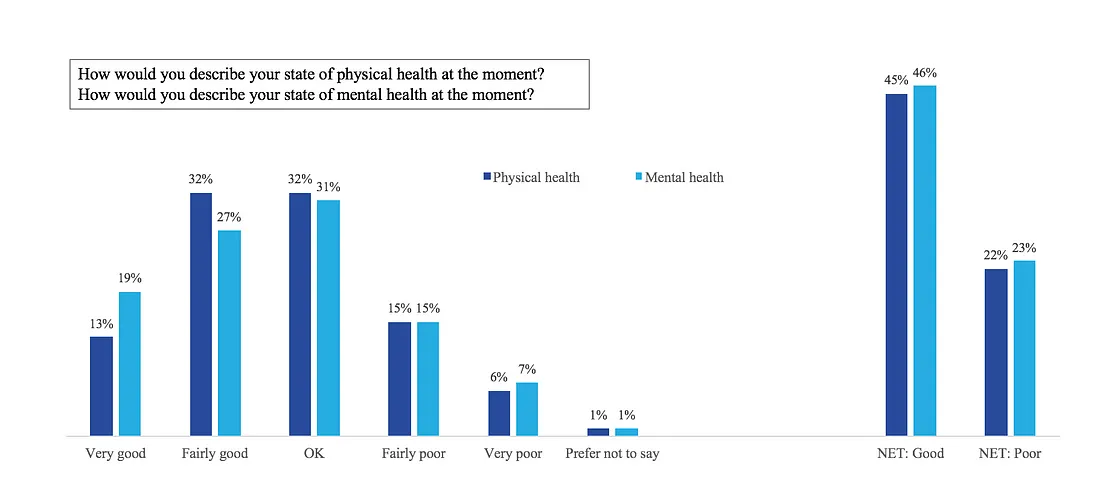
In the latest survey for which data is available, Spring 2023, 1 in 5 said they had experienced “mental health issues that needed treatment or support”.
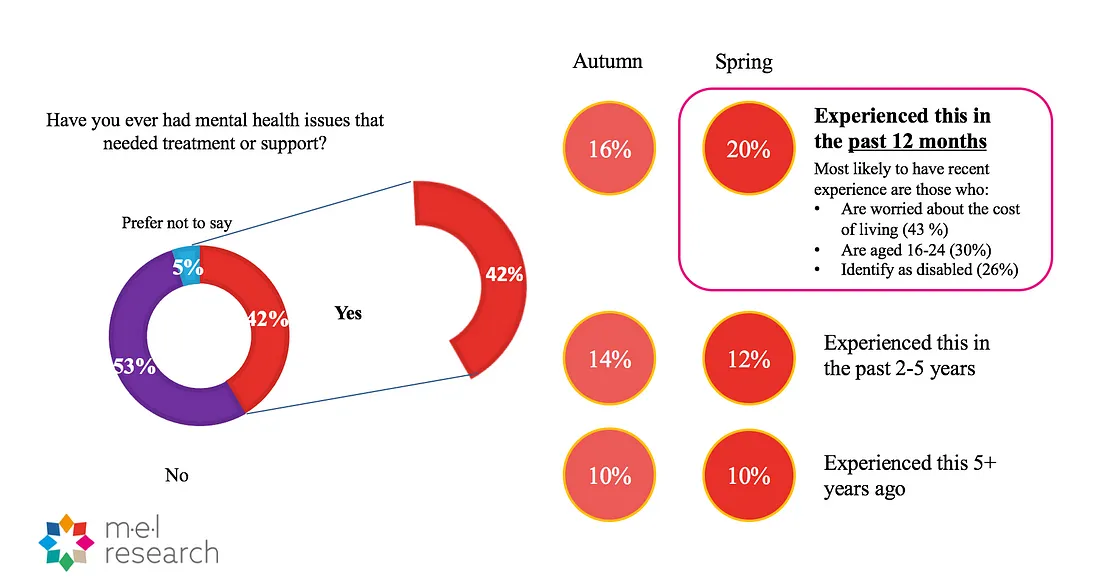
Note that, unlike some of the ‘official government surveys’ or surveys carried out by the health professions, we don’t use terms like ‘disorder’ or ‘psychiatric disorder’ which can, of course, record lower numbers of ‘people with mental illness’ (even then the numbers are worryingly high), instead we ask, in plain English, if they have had “mental health issues that needed treatment or support”.
Also note this doesn’t mean they got the treatment or support they needed, that’s another issue altogether!
We know that many don’t seek the support they need or cannot get access to the support they need.
In January 2023, the NHS reported that for the first time ever, the number of children on waiting lists for Child & Adolescent Mental Health Services (CAMHS) had exceeded 1 million.
And, sadly, we also hear cases every week of people being referred to Adult Mental Health Services because they are having thoughts of suicide and they were put on a 6-month waiting list — yes, you may need to re-read that, a 6-month waiting list for someone thinking of ending their life!
With 3 ‘waves’ of our survey now completed, we can start to look at patterns and even possible trends, although we would be very cautious about ‘talking trends’ at this stage with just the 3 data points.
The pattern is certainly clear though:
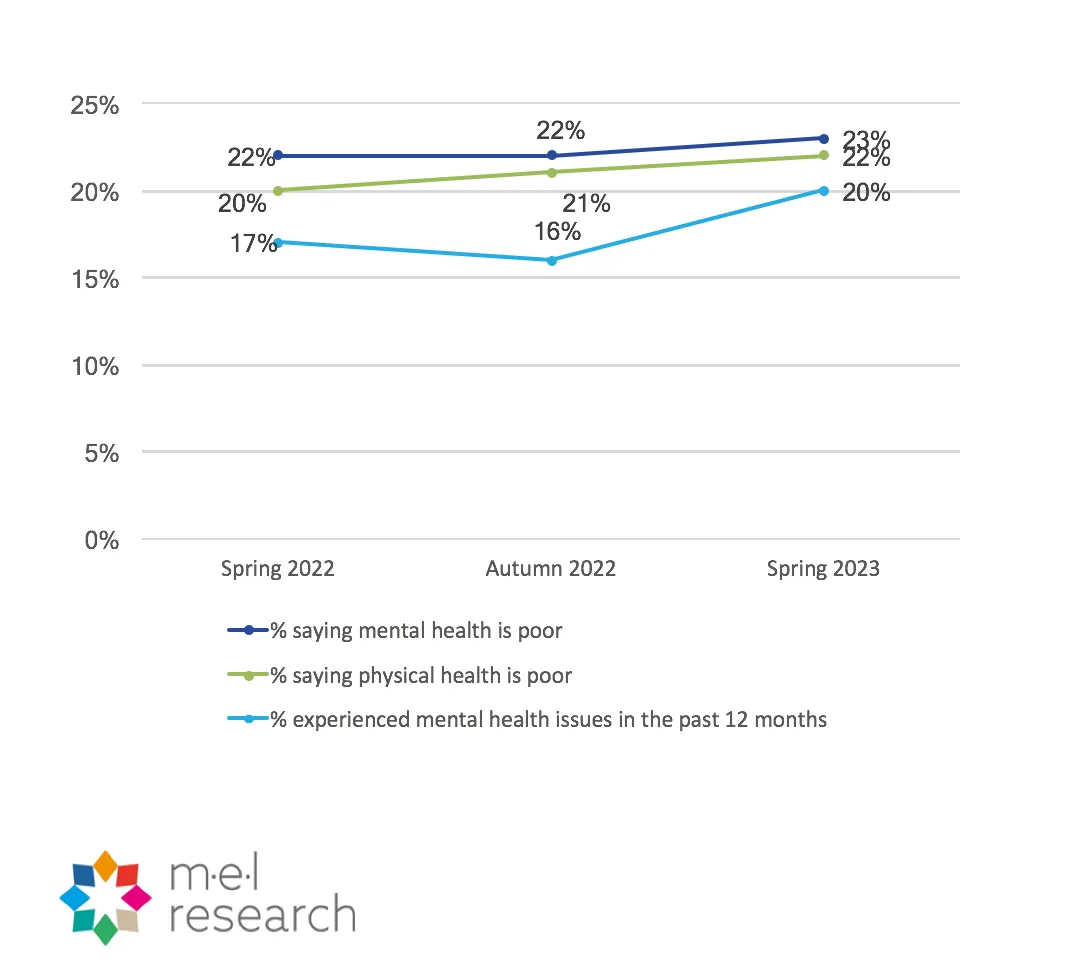
Exposure to Mental Health Issues
Almost 2 in 3 UK adults have known someone “with mental health issues that needed treatment or support”:
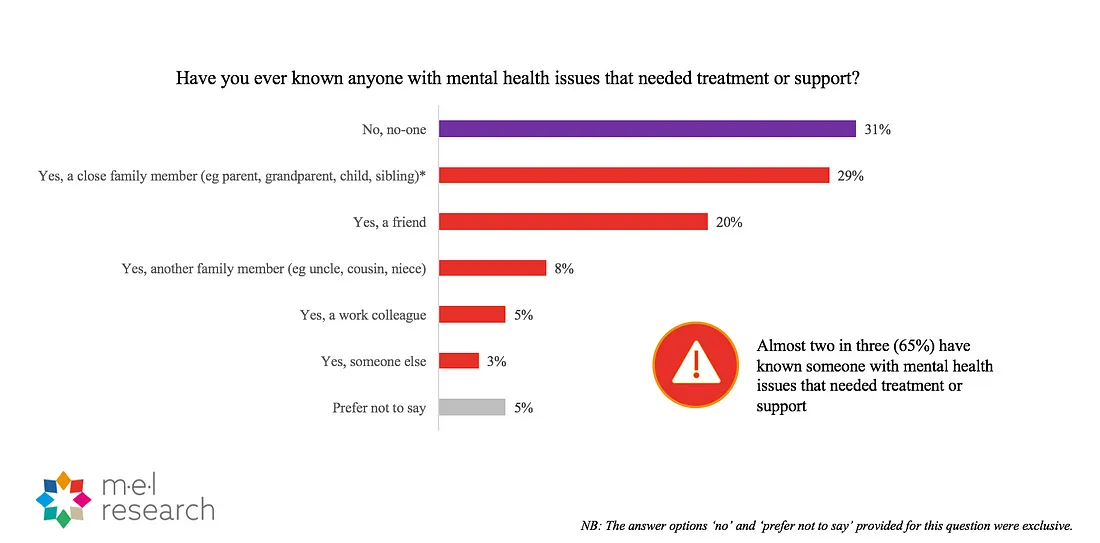
Incidence of Thoughts of Suicide, Plans, and Attempts
All of the training courses that cover suicide prevention encourage us to ask direct questions to people because asking about suicide doesn’t ‘put the idea in the head’ of someone who isn’t suicidal and it creates an opportunity for the person who is suicidal to simply and briefly answer that direct question, and then get the support they need.
In our survey, we ask a similarly direct question “Have you ever had thoughts about taking your own life?”.
Based on the Spring 2023 Survey, 2 in 5 say they have. 1 in 5 say it’s something they have seriously considered. Around 1 in 8 say they have acted on these thoughts in terms of either making a plan (6%) or making a suicide attempt (7%).
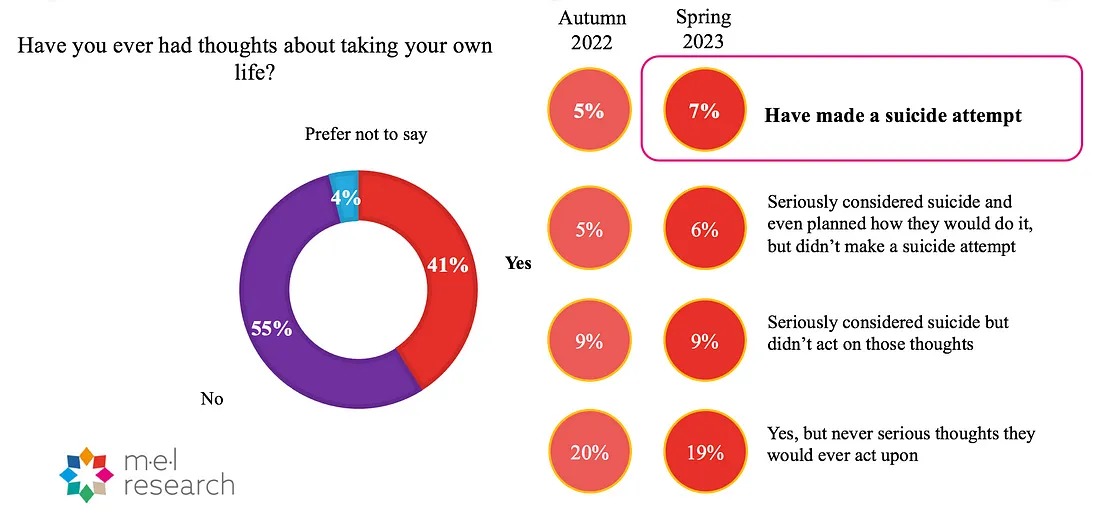
When we share these results, we sometimes find people are shocked to hear that as many as 1 in 15 (7%) of those aged 16+ in the UK (say they) have made a suicide attempt but that is the same figure as recorded by the Adult Psychatric Morbidity Survey from 2014 which was quoted earlier — a survey with a random probability sample of 7500 and weighting designed to be fully representative of the population of England and which also includes an anonymised self-completion sample to check on any under-reporting (there is none!).
Although also note that the Adult Psychiatric Morbidity Survey asks a different question, not one we would endorse it has to be said as it mentions a specific method (and a method used much more frequently by women, so a risk of bias in the results), “Have you ever made an attempt to take your life, by taking an overdose of tablets or in any other way?”
We also often find that, after the initial shock of processing the survey result that 1 in 15 adults in the UK (say they) have made a suicide attempt, people start trying to ‘play it down’ by rationalising like, for example, ‘ah, I see, so the question asks about ‘ever’ so that could be a suicide attempt at some point in their life over the course of a long life’ (not that that makes it any more palatable!).
But there are two problems with this ‘playing it down’ mindset. Firstly, the % saying they have ‘ever made’ a suicide attempt is much higher in younger people than in older people.
Secondly, the latest wave of the UCL Millennium Cohort Study found that 7% of 17-year olds (say they) have made a suicide attempt — yes, another one worth re-reading, 7% of 17-year olds trying to end their lives!
Again, with having 3 waves of our own survey, we can see the patterns in the data. The proportion seriously considering suicide has remained around 1 in 5. The % saying they’ve made a suicide attempt was 7% in both of the Spring Surveys, so consistency there too.
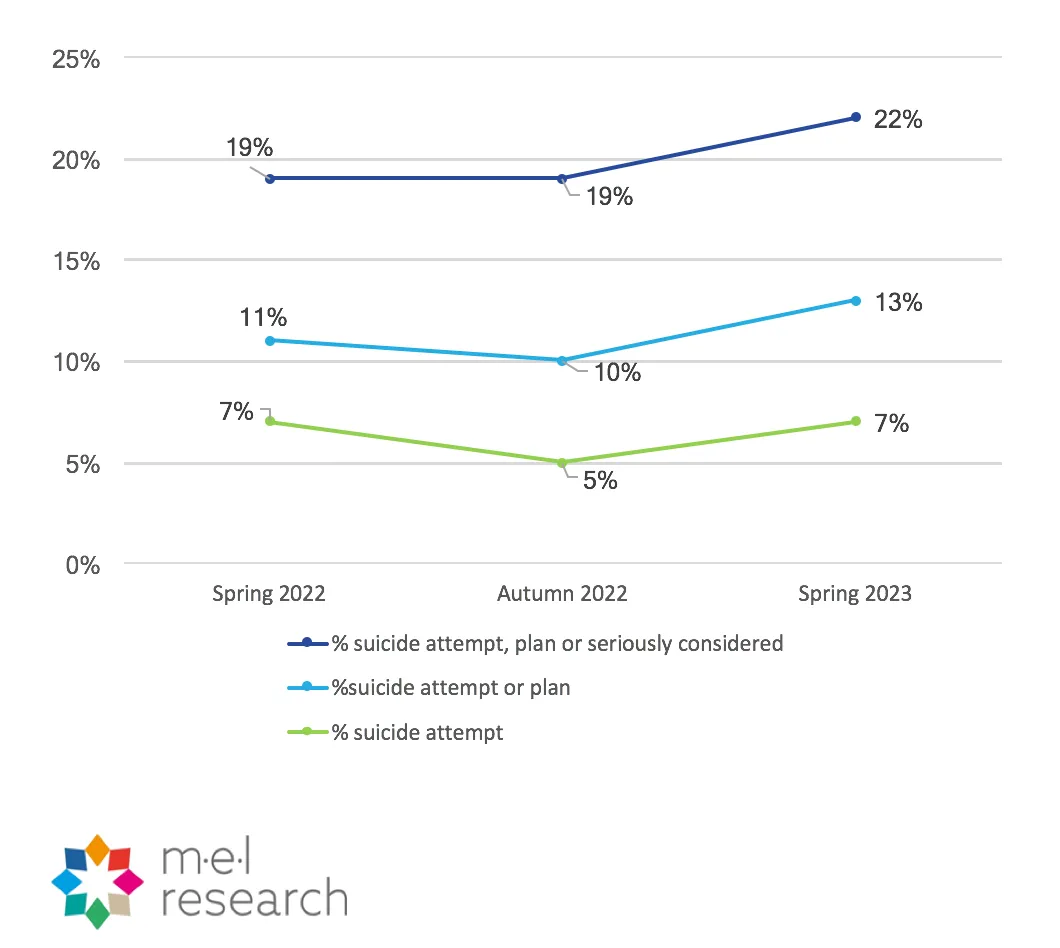
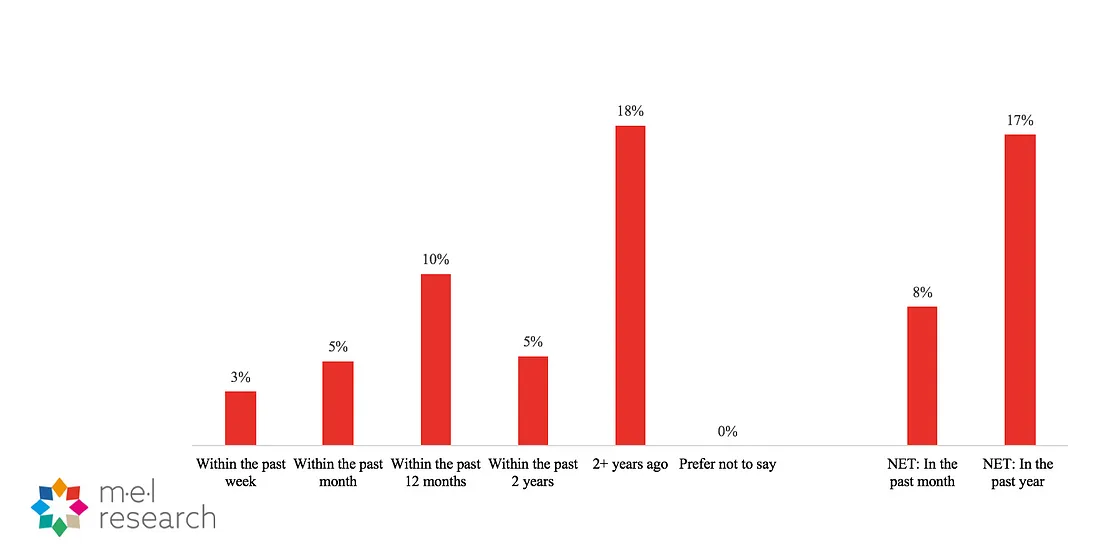
Exposure to Suicide
Among the UK population as a whole, 2 in 3 have been exposed to suicide in some way.
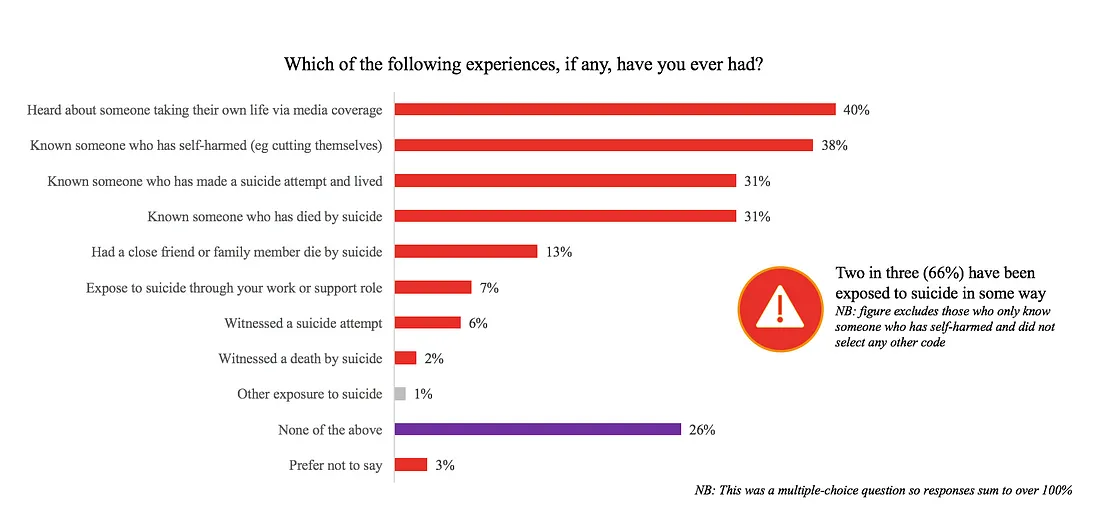
We often say in our advocacy and campaigning ‘suicide can affect anyone’ and ‘everyone can help prevent suicides’.
We can also say that ‘2 in 3 people in the UK have had some exposure to suicide (eg losing someone to suicide, knowing someone who has died or made an attempt, witnessed a suicide, etc) — but the number of people who openly talk about suicide (and suicide prevention) is nowhere near 2 in 3.
The figures for exposure to suicide have been very consistent over the 3 waves of the survey so far.
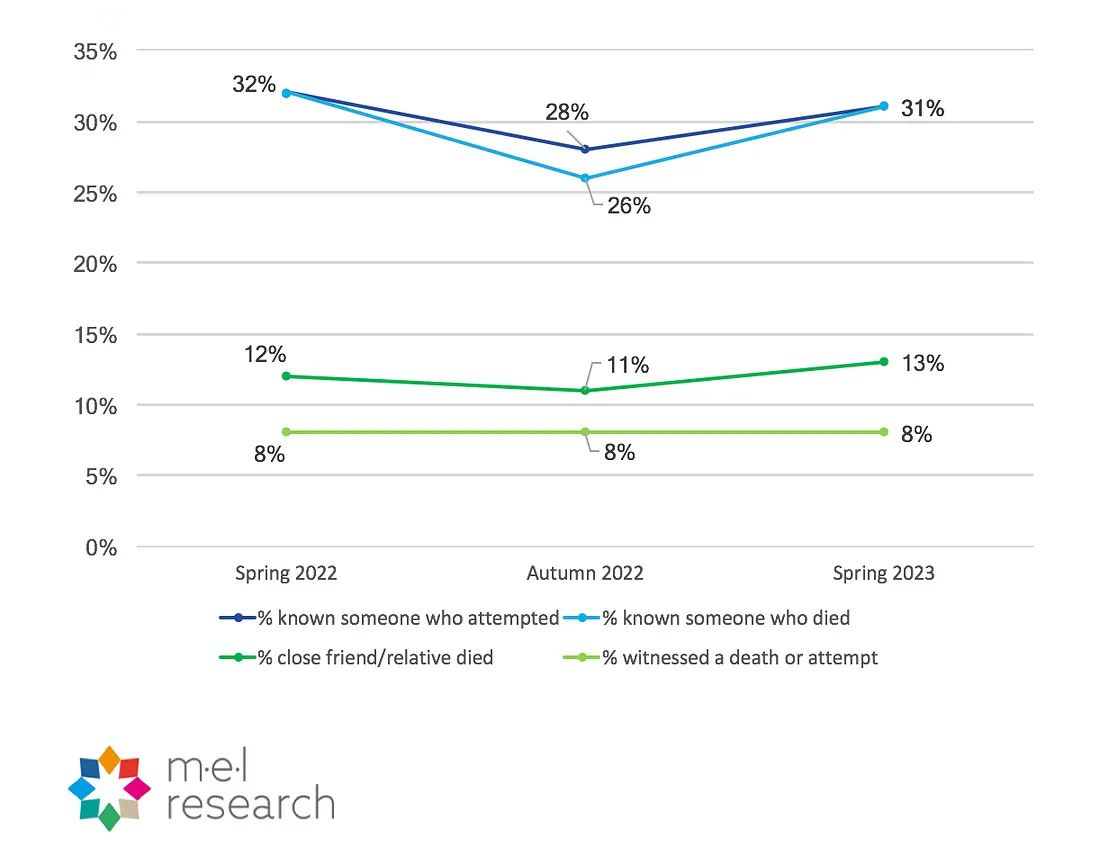
Levels of Confidence in Talking about Mental Health and Suicide
In the Survey, we asked about some key scenarios around information or support around mental health & suicide prevention, and asked about the extent to which people would feel confident in each scenario — very confident or fairly confident (to add together for a total ‘confident’ measure), not really confident or not at all confident (to add together for a total ‘not confident’ measure) or ‘don’t know’ (which clearly is nearer to ‘not confident’ than ‘confident’).
There are just 3 scenarios where a majority of UK adults are confident — “Where you could get support if you were struggling with your mental health” (58% confident, though only 17% very confident and 31% not confident); “Where to go to get information about suicide and suicide prevention” (57% confident, though only 16% very confident and 33% not confident); and “How to spot the signs that someone might be struggling with their mental health” (54% confident, though only 11% very confident and 38% not confident).
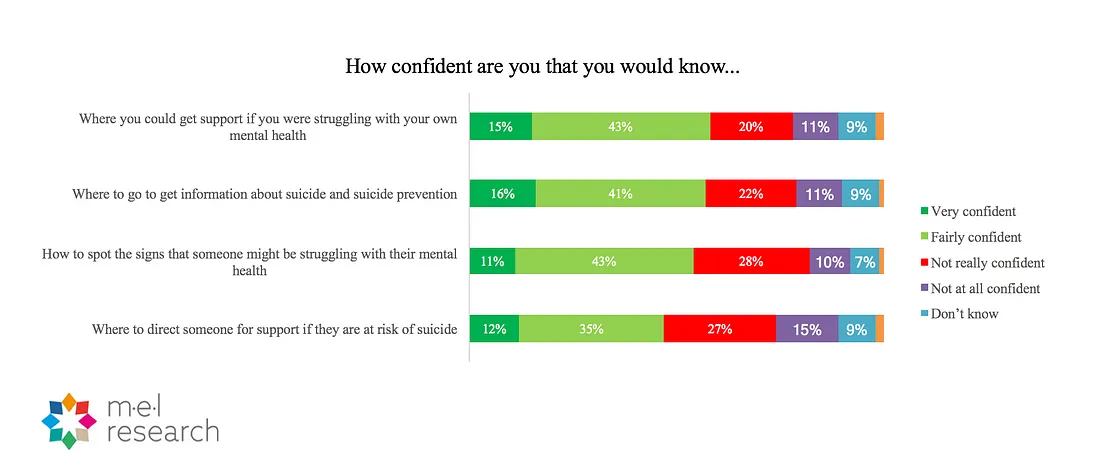
In the above chart, we also have “Where to direct someone for support if they are at risk of suicide”. For this, fewer than half are confident (47%) with almost as many (42%) not confident.
In the chart below, confidence levels are even lower.
For the absolutely crucial, potentially life-saving starter question (covered in all the suicide prevention training courses) “How to best ask someone if they are having suicidal thoughts”, only one in three (33%) are confident and more than half (54%) are not confident.
Interestingly, for “How best to continue the conversation if someone is thinking about suicide”, the gap narrows — 42% confident, 47% not confident.
So, it appears to be significantly harder to start the conversation than to continue the conversation.
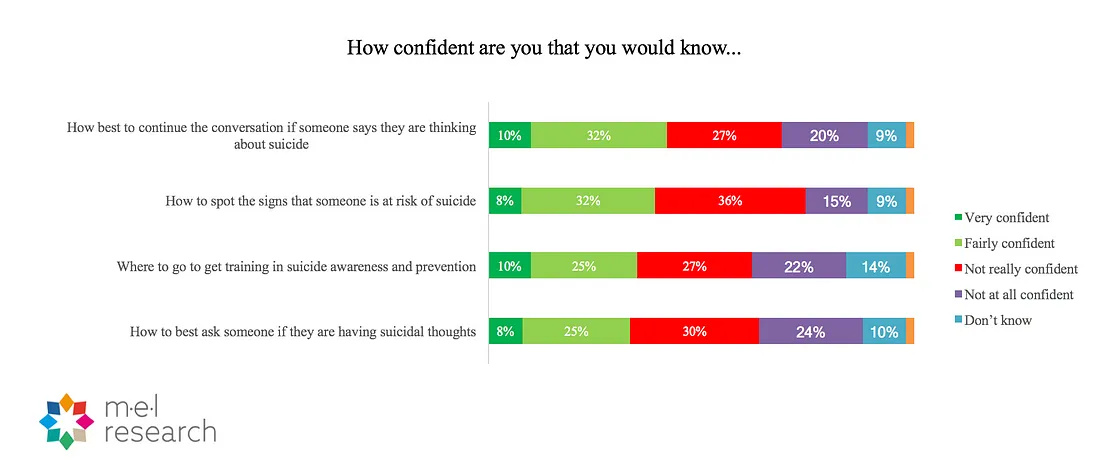
And that’s why it’s so important to get some basic training — to be able to start that conversation, and then continue.
Yet when asked about “Where to go to get training in suicide awareness and prevention”, only one in three (35%) say they are confident, with half (49%) saying they are not confident, and a further one in seven (14%) answering ‘don’t know’ which, in this context, is clearly not confident.
One other scenario was given to those taking part in the survey — “How to spot the signs that someone is at risk”.
This is something Steve Phillip and I at The Jordan Legacy are asked all the time — ‘what are the symptoms, what are the signs, how can you tell someone is struggling, how can you tell if someone might be thinking of ending their life?’.
This is one of the key topics we cover in our talks and workshops, including Steve’s very popular signature talk “The ‘S’ Word” and our highly acclaimed workshop “Having Difficult Conversations, including the ‘S’ Word”. You can book Steve to speak at your conference or event via this link.

Well, when asked about “How to spot the signs that someone is at risk of suicide”, only two in five (42%) are confident, whilst half (51%) are not confident (and 9% answer ‘don’t know’).
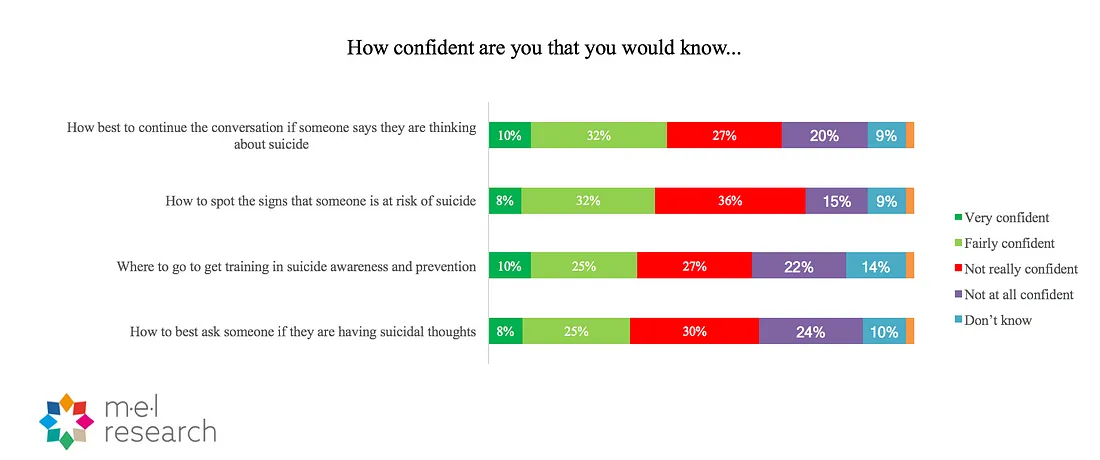
Education and training is crucial for two reasons.
To learn how to better ‘spot those signs & symptoms’.
But also, because it’s not always easy to ‘spot the signs’ and, sadly, with many suicide deaths, those bereaved (including close family, best friends, team members at work, and neighbours) say ‘there weren’t any signs, we didn’t see it coming’, we need to ‘ask the question’…and, because it’s hard to ‘ask the question’, we need to ‘take the training’.
Sources of Information, Education and Training
When asked about which ways they have learned about mental health and suicide, the top answer by far is “Read information on relevant websites such as Mind or Samaritans” — more than 1 in 3 say they have done so (which, of course, means the majority haven’t, and 2 in 5 have not used any of these sources or resources).
Next (at 18%) is “Learned from listening to someone who has had suicidal thoughts or experienced a suicidal crisis”, and it’s interesting to know that almost 1 in 5 are learning from this type of lived experience, significantly more in fact than “Learned from listening to someone who has lost someone to suicide” (1 in 8, 13%).
Because more (prominent) public speakers & campaigners tend to be people bereaved by suicide rather than people who have experienced a suicidal crisis, there can be a tendency to think this is a more common source of information and education but our data suggests otherwise.
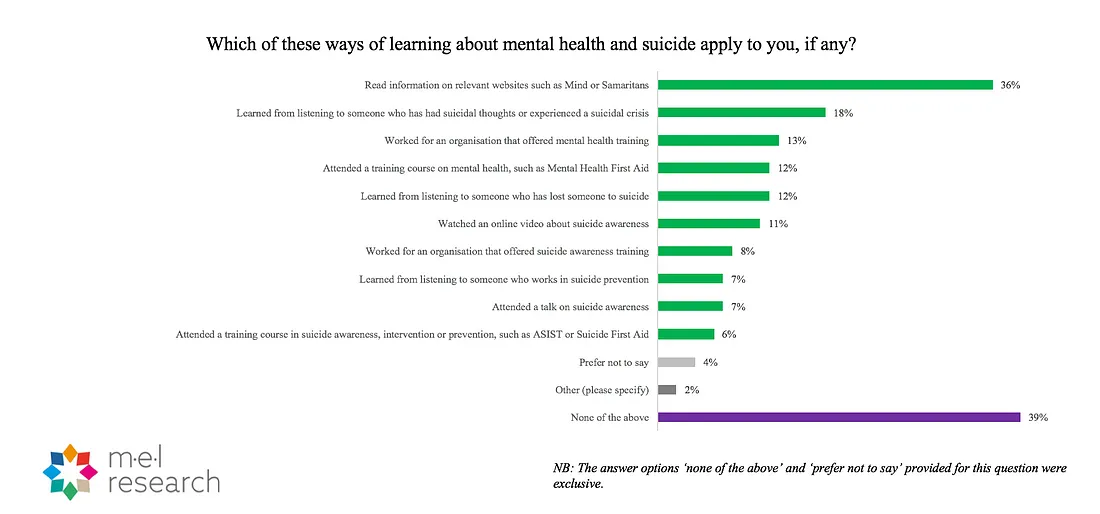
One in eight (12%) say they have “Attended a training course on mental health, such as Mental Health First Aid”, although only half this number (6%) say they have “Attended a training course in suicide awareness, intervention or prevention, such as ASIST or Suicide First Aid”.
When we combine those two categories, ie attended either a mental health course or a suicide awareness/intervention/prevention course, the total is one in seven (14%). A case of ‘good but could be much much higher’.
Impact of Training
You won’t be surprised to hear that those who have attended training are considerably more likely to be confident in having conversations about suicide.
This will be the main feature of my next article-report, going into more detail on those impact figures. So watch this space!
Time for Action — Creating Hope Through Action
Meanwhile, let me reiterate the practical actions you can take because it’s all about action at the end of the day — and, for the third year in a row, the theme of World Suicide Prevention Day is ‘Creating Hope Through Action’.
If you haven’t completed the Zero Suicide Alliance (ZSA) Gateway training, please, please, please do so NOW!
It’s evidence-based, it’s lived experience informed, it’s NHS-endorsed, it’s been completed 2.5 million times (but still nowhere near enough!), it’s online, it takes just 20 minutes, and it’s free!!!
And check out all of the other great courses out there, including all those actively supported by The Jordan Legacy such as Mental Health First Aid and Suicide First Aid (including those courses delivered through The Jordan Legacy’s partners Tara Powell and Steve Carr), and ASIST, and our collaborative partnership with 4MentalHealth.
Hope for Life!
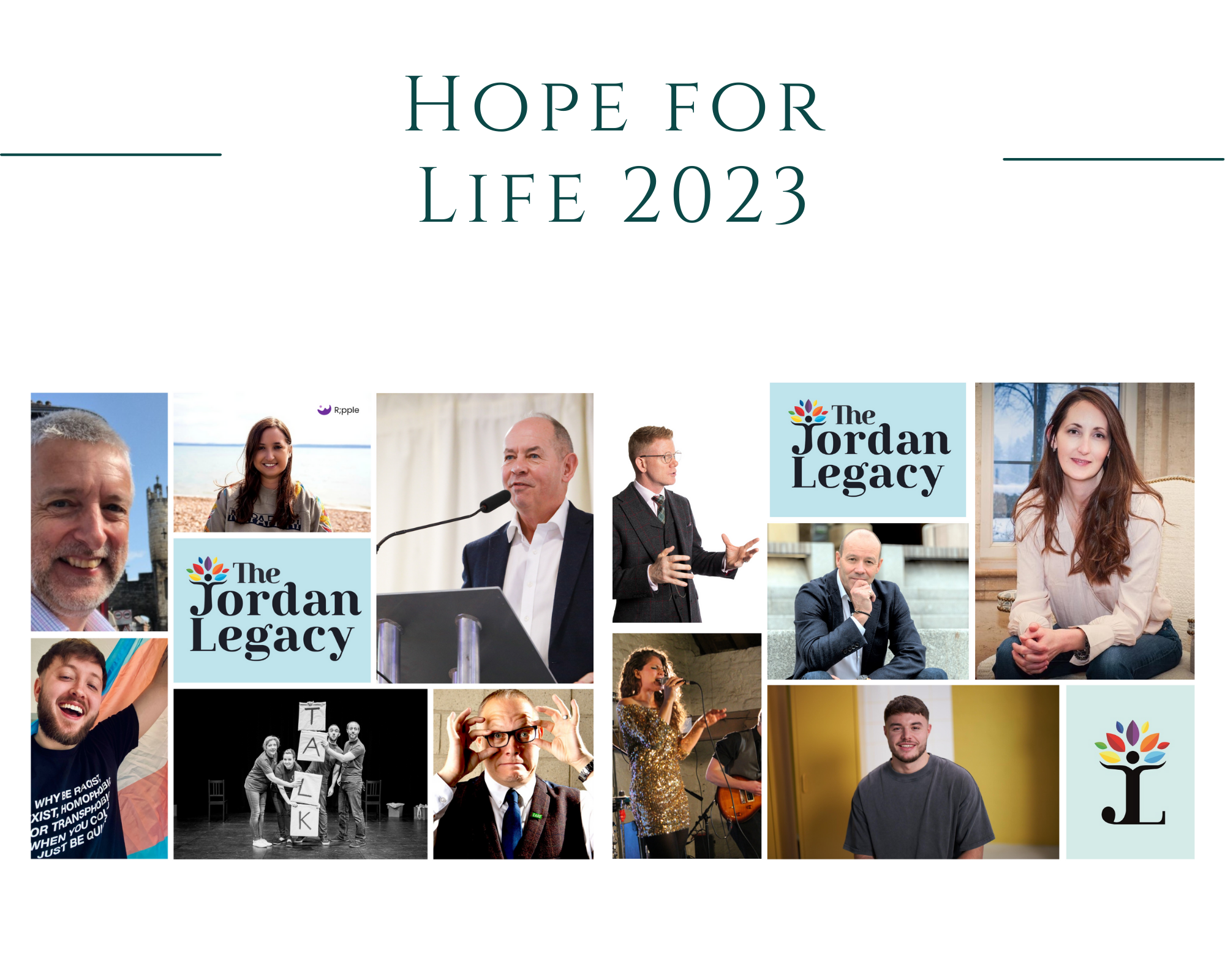
The first Hope for Life Conference in December 2021 was an incredible event — so moving to have so many people with lived experience in the room, brilliant talks and performances (from music to immersive theatre), and it had a ripple effect impact that extended a long way in many directions…
…including sowing the seeds for the Baton of Hope in the closing conversation between myself, Steve Phillip & Mike McCarthy (we initially agreed to have our first meeting to develop the concept in January 2022 but couldn’t wait so it was 16 December 2021)…
…and connecting us to so many people we now collaborate with regularly in working towards our shared vision of a ‘Zero Suicide Society’.
Here’s the video highlights from that first Hope for Life Conference:
Paul Vittles is a researcher (FMRS), consultant, coach and counsellor who specialises in mental health and suicide prevention. Paul has lived with mental illness for 20 years, and worked professionally in suicide prevention for more than 10 years. Paul’s role was The Jordan Legacy’s Chief Facilitator, Zero Suicide Society Transformation Programme.
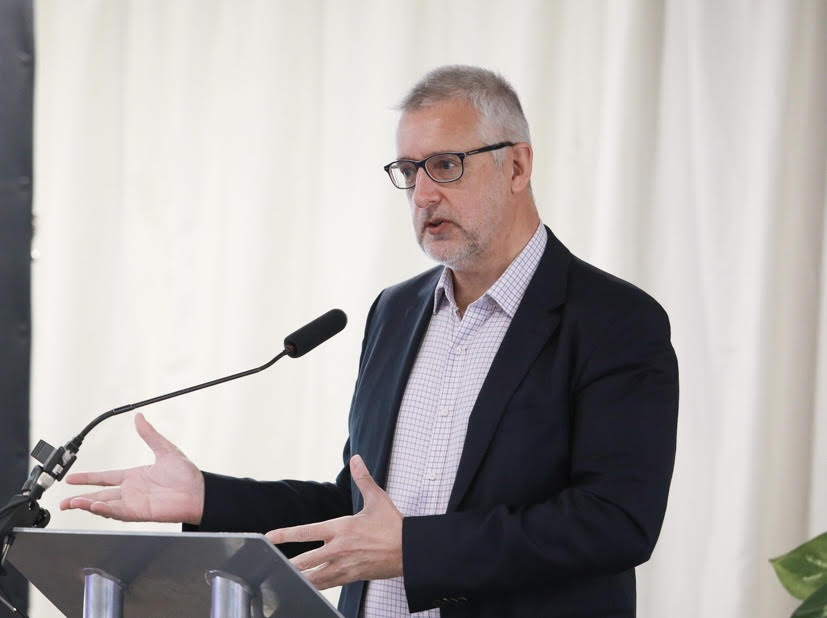
If you want to support the work The Jordan Legacy does, you can donate via the website or you can make a donation specifically to support The Jordan Legacy’s action research project via this JustGiving page link.


